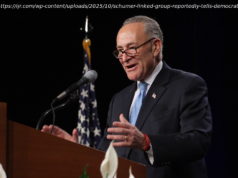By TOM MURPHY AP Health Writer Health insurance markets created by the Affordable Care Act may not be on the verge of collapse, but President Donald Trump could nudge them in…
Health insurance markets created by the Affordable Care Act may not be on the verge of collapse, but President Donald Trump could nudge them in that direction by following through on his plan to let the Obama-era law fail.
Simply raising the threat of failure makes already-skittish insurers more nervous, and could lead them to stop selling coverage in some areas. And there are a few moves the administration could make that would further destabilize markets. That includes withholding subsidy payments to insurers that the law established or declining to enforce a mandate requiring people to buy coverage.
On Wednesday White House officials announced it would pay the subsidies this month, a relief to some who feared the administration would try to subvert the insurance market after the Republican push to dismantle the Affordable Care Act and replace it fell apart this week in the Senate. But spokeswoman Sarah Huckabee Sanders said the status of those payments is « undetermined beyond that » – which preserves an important bargaining tool for the administration and also keeps the cloud of uncertainty above the insurance market.
« This is actively trying to provoke failure, » said Sheryl Skolnick, a Mizuho Securities USA analyst who follows the insurance industry. « This is a bizarre policy outcome. »
Customers looking to buy insurance in the Affordable Care Act’s marketplaces have seen prices rise and choices dwindle in recent years, and that trend looks set to continue. That has led to claims by some Republicans that the law is collapsing. Trump took to Twitter this week to tell Americans he has always said, « Let ‘ObamaCare’ fail and then come together and do a great healthcare plan. »
Health policy experts say the market isn’t failing, even if it is wobbly. But there are a few things the administration can do that would make insurers even more likely to raise prices or pull out of markets altogether.
WHAT ARE THE SUBSIDY PAYMENTS?
Money paid to insurers by the federal government to help consumers with low incomes cover out-of-pocket expenses like deductibles and copayments. They are separate from income-based tax credits that help people afford coverage, the monthly expense known as the premium.
The Trump administration can withhold those subsidy payments to insurers, the result of a ruling by a federal judge in a case filed by Republicans against the Obama Administration. The ruling is on hold. White House officials said Wednesday the subsidies will be paid this month, but spokeswoman Sarah Huckabee Sanders said the status is « undetermined beyond that. » Trump has suggested withholding the money to force Democrats to negotiate.
WHAT IF THE SUBSIDIES GO AWAY?
Premiums for insurance on the exchanges could soar.
Insurance companies would still be forced to keep customer out-of-pocket costs like deductibles at the same level whether they get a subsidy from the federal government to help offset that or not. In order to make up that shortfall, they would likely charge far higher premiums.
Insurance regulators in several states are asking companies to file two sets of rates for next year, one assuming these payments do not return, and one assuming that they do. Ana Gupte, an analyst at Leerink, surveyed several states and found that insurers are asking for price hikes of around 36 percent when they assume the subsidies go away and about 18 percent if they stay.
WHAT IS THE MANDATE?
The Affordable Care Act requires most Americans to buy health coverage or face a fine. It’s one of the most unpopular elements of the law, but insurers need it to compel healthy people to sign up for their coverage. Like with all insurance, the people who buy insurance but don’t use it help pay for the people who suffer a problem and need help.
WHAT CAN THE TRUMP ADMINISTRATION DO?
Not enforce the requirement.
The mandate in the current law failed to compel everyone to buy coverage, but insurers say it helped. Healthy customers might not be as motivated to sign up if the threat of a fine goes away, and that would push prices up for everyone and further destabilize the market.
Insurers also are concerned about whether the administration will promote enrollment in the plans as the sign-up period for 2018 coverage approaches this fall. The Obama administration heavily advertised HealthCare.gov, but those promotions were scaled back after Trump took office in January.
HOW WILL INSURERS RESPOND TO ALL THIS UNCERTAINTY?
« Further inaction at the federal level will lead to higher premiums, fewer consumer options, and, in some places, collapsing markets, » leaders of the National Association of Insurance Commissioners said in a letter sent Wednesday to Senate leaders.
Most insurers who sold coverage on the exchanges for this year have made preliminary plans to return in 2018. Many, especially non-profit Blue Cross-Blue Shield plans, say they are hesitant to abandon markets, especially if they have been there for decades. But insurers have until late September to decide for sure.
Copyright 2017 The Associated Press. All rights reserved. This material may not be published, broadcast, rewritten or redistributed.






